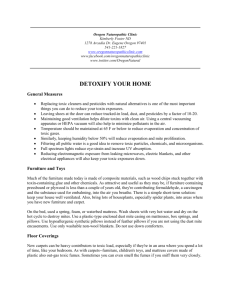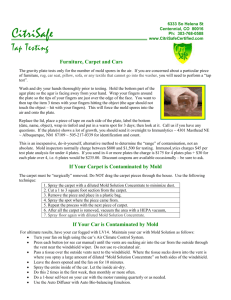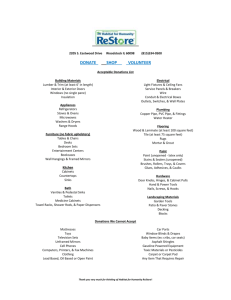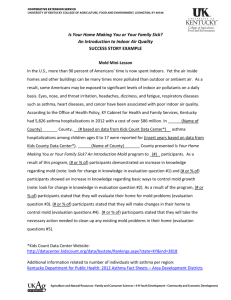Chapter Four Making Your Environment Safe
advertisement
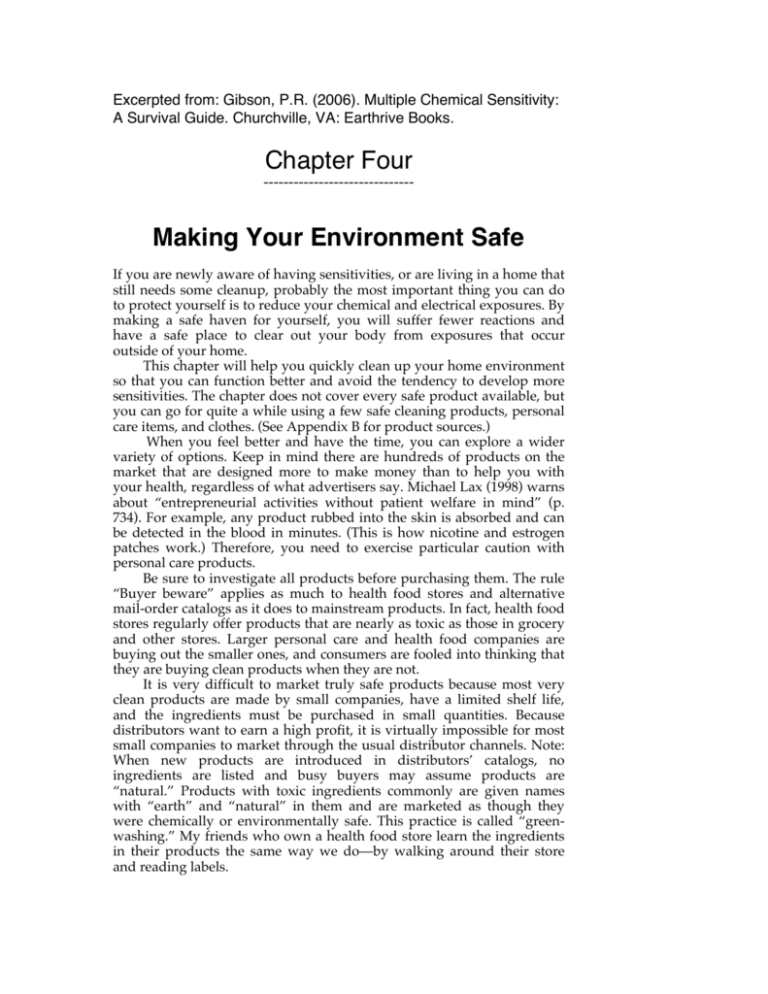
Excerpted from: Gibson, P.R. (2006). Multiple Chemical Sensitivity: A Survival Guide. Churchville, VA: Earthrive Books. Chapter Four ------------------------------ Making Your Environment Safe If you are newly aware of having sensitivities, or are living in a home that still needs some cleanup, probably the most important thing you can do to protect yourself is to reduce your chemical and electrical exposures. By making a safe haven for yourself, you will suffer fewer reactions and have a safe place to clear out your body from exposures that occur outside of your home. This chapter will help you quickly clean up your home environment so that you can function better and avoid the tendency to develop more sensitivities. The chapter does not cover every safe product available, but you can go for quite a while using a few safe cleaning products, personal care items, and clothes. (See Appendix B for product sources.) When you feel better and have the time, you can explore a wider variety of options. Keep in mind there are hundreds of products on the market that are designed more to make money than to help you with your health, regardless of what advertisers say. Michael Lax (1998) warns about “entrepreneurial activities without patient welfare in mind” (p. 734). For example, any product rubbed into the skin is absorbed and can be detected in the blood in minutes. (This is how nicotine and estrogen patches work.) Therefore, you need to exercise particular caution with personal care products. Be sure to investigate all products before purchasing them. The rule “Buyer beware” applies as much to health food stores and alternative mail-order catalogs as it does to mainstream products. In fact, health food stores regularly offer products that are nearly as toxic as those in grocery and other stores. Larger personal care and health food companies are buying out the smaller ones, and consumers are fooled into thinking that they are buying clean products when they are not. It is very difficult to market truly safe products because most very clean products are made by small companies, have a limited shelf life, and the ingredients must be purchased in small quantities. Because distributors want to earn a high profit, it is virtually impossible for most small companies to market through the usual distributor channels. Note: When new products are introduced in distributors’ catalogs, no ingredients are listed and busy buyers may assume products are “natural.” Products with toxic ingredients commonly are given names with “earth” and “natural” in them and are marketed as though they were chemically or environmentally safe. This practice is called “greenwashing.” My friends who own a health food store learn the ingredients in their products the same way we do—by walking around their store and reading labels. In the Home: The Big Stuff Some of the accommodations that are needed to make a home chemically safe may be so extensive and may involve such costly structural change that it becomes necessary to move. You will have to assess your location and house structure before you can decide if your home is safe enough not to further jeopardize your health. Can This House Be Saved? The following questions may help you to sort out what works from what doesn’t: Outside Your Home Is your home located near polluting traffic or industry fumes that will make it impossible to go outside or to open your windows, even if the inside of the house is made safer? If you are gas-sensitive, are you subject to neighbors’ heating fuel smells, gas from propane cookers or dryers, or fumes from neighbors who do their own auto work? Do close neighbors use lawn treatments that will expose you to dangerous herbicides and pesticides? Does the local county do aerial spraying for mosquitoes, gypsy moths, or other insects? Is your home downwind or downstream from any large polluting agencies most of the time? (Wind directions vary, but they have common patterns.) Is your house near large sources of EMFs? That is, are there hightension electrical wires or power stations close by? Where is the closest cell phone tower? You can acquire a meter to measure magnetic fields for both outside and inside sources. (See Appendix B for product sources.) Although there are products such as special paints and other materials that are said to screen or filter EMFs, it is easier not to enter into a situation where you will have to attempt these difficult measures. Even if you do not think that you are personally “sensitive” to EMFs, the health effects from these exposures appear to be harmful to everyone. Problematic can be cell phone towers, radio wave towers, and other sources of EMFs. You may need to find where the closest of these facilities is located and decide whether or not it is a “safe” distance. However, more and more of these facilities are being located in residential areas with minimal input from the community. So, even if your home is presently not affected, it could be in the future. The towers are being disguised as trees and cacti, making it difficult to know their locations. People very knowledgeable about electromagnetic sensitivities believe that you should never live within a mile of a radio or cell phone tower. Farther is better. It may be that four miles is about as safe of a distance as you will be able to find. R. Bruce McCreary believes that all people with MCS or ES should own a meter with which to measure their environment in order to lower their daily exposures and prevent the development of or worsening of ES. He does not endorse denial as a preventative for ES, as a number of people have ignored this issue and developed severe ES as a result. He also claims “ES makes MCS seem like a walk in the park.” (See Appendix B for Bruce’s suggested EMF meters.) Inside Your Home Is your home heated with gas or oil? If so, is the cost of a changeover to electric heating worth it as the house is otherwise safe? Is your house so full of formaldehyde-offgassing materials, such as particleboard, that you could never adequately reduce the emissions? Both plywood and particleboard have formaldehyde in their contents. Particleboard is a bigger concern because it contains both a larger percentage of formaldehyde-containing glue, and a more toxic form of formaldehyde (i.e., urea formaldehyde). The highest levels of offgas occur in the first year after construction; but offgassing may continue for a number of years. If you live in a prefabricated or mobile home, chances are that particleboard makes up much of your flooring, external walls, and roof panels. However, you can seal cabinets, paneling, and other particleboard with sealants made to prevent offgassing from porous surfaces, such as mortar, plywood, concrete and others. If you can tolerate the product, it may be worth sealing some of the surfaces that are offgassing (See Appendix B for product sources.) Does your house have a stubborn mold problem that cannot be remedied? For example, an old house with a lot of shade or a wet basement will expose you to more molds. Not all molds are toxic, but some molds produce mycotoxins, which are mold metabolites toxic to humans. Penicillium, Aspergillus, and Stachybotrys are the most common fungi that can grow indoors and make toxic metabolites. In addition, Cladosporium, Alternaria, Aureobasidium, and Fusarium are outdoor fungi that can also grow indoors and may trigger hay fever or asthma (Dalton, 2004). Black mold and its metabolites are serious health threats that have caused life-threatening respiratory problems in both children and adults. In infants it can cause lung bleeding. The deaths of nine infants in Cleveland Ohio were traced to the black mold Stachybotrys chartarum/atra that grew in recently flooded homes (Meredith, l997). This particular mold grows in areas that have had standing water and grows readily on wood, cardboard, and clothing. The mold problem is so potentially lethal that there are now mold attorneys in the U.S. Two congressional amendments (HR 5040 and HR 1268) have also been proposed and, if passed, would provide research, education, and guidelines in relation to indoor mold, as well as assistance for victims (“Mold legislation,” 2003). Of course. you can still find Abba Terr and Ronald Gotts stating that molds are not demonstrated to be dangerous. If you have a small area of mold you can clean it with bleach (if tolerable, although chlorine is not good for the environment), vinegar, or grapefruit seed extract (although some now question whether the antimicrobial effect of GSE is actually due to additives). EPA suggests using gloves and goggles even for small clean-ups. Be careful not to disturb spores in the process if possible. For larger problems, you may need a mold remediator, but be careful that chemical cleaners used in the process do not endanger you further. You can search your home for moldy areas, but because mold can grow almost anywhere, such as in drywall or insulation, under floors, or in carpet, it may be difficult to pinpoint problem locations. Some companies have begun to train dogs to sniff out mold in homes. A mold test kit may help you. However, in discussing various ways to measure indoor mold, mold expert J. David Miller says that it is not possible to leave the samplers out long enough to accommodate the large fluctuations in particles. The plates therefore may not provide a true measure of the mold concentration (Miller, 2003). You may be able to prevent further mold build up in particular areas by taking steps such as venting any moisture sources to the outside (cooking, dryers, bathrooms) and other actions. (Sources for mold test kits are in Appendix B.) If none of the problems is insurmountable, then it may be worth cleaning up your current home. Note: If a problem really is not fixable, it’s better to face it and change location than to continue living in a to which you are attached, but is making you ill. It is imperative to avoid a further decline in your health and denial will not serve you well here. It is much easier to prevent further decline than to recover from more serious injury. Sometimes it can be a judgment call, but we usually know when we are kidding ourselves. On the other hand, relocation, either locally or long-distance, should be well thought out, as it is full of snares. The following suggestions are some of the more permanent kinds of changes you may need to make to clean up your home: Petrochemicals: Appliances and Heat Appliances. If your home has natural gas or propane appliances, such as a stove, dryer, or water heater, you will want to replace them with electric ones if you tolerate electricity better. Some environmentally aware people advocate the use of gas because it is cheaper than electricity, but health effects also must be factored into the cost. Gases are sensitizers and rank high on the list of chemicals to which people with MCS react. As early as the 1950s, Dr. Theron Randolph (Randolph and Moss 1982) discovered that people have allergic-like adverse reactions to petrochemicals, including gases and heating oil. There is also evidence that women who use gas stoves have more respiratory problems than those who use electric ones (Jarvis, Chinn, Luczynska, et al. 1996). The nitrogen dioxide from cooking gas is a home pollutant. You can consider buying used appliances to save on finances, but washers and dryers in particular may be problematic because of lingering odors from previously used fabric softeners and detergents. Note that when constructing his inpatient unit for people with chemical sensitivities, Randolph found that some patients were not able to clear their symptoms until the wood floors were replaced, as the floors had absorbed petrochemicals from previous gas heating. You may not necessarily be completely safe just because you switch to electric. Electrical cooking does emit EMFs and you many want to measure the electromagnetic field from an appliance before purchasing it. Some EMF sensitive people cook on electric hotplates or toaster ovens because of the electrical fields from the larger appliances. If necessary, these can be used outside or on a porch. Microwave ovens have their own dangers and probably should not be used at all. Microwaved food is questionable and the ovens themselves can trigger immediate symptoms for some. Heat. A larger obstacle is heat. If you have forced air oil or gas heating, combustion products are entering your house air. Some of the newer heating units are self-contained in a sealed combustion unit, with the heating fuel located in a sealed chamber and vented to the outside. With the sealed combustion unit, the air that heats your house does not mix with the fuel source. If the unit is vented to the outside, then you may be able to keep petrochemicals out of your indoor air altogether. Another way that some people keep petrochemicals out of their indoor air is by putting their heat source in a garage or another separate building. However, in both of these scenarios, you still have petrochemical emissions very close to you, and you will be exposed to them when you go outside. If you use diesel oil, it is 95 percent as heavy as air and will rise very slowly. Propane is actually heavier than air and, therefore, lingers in low areas unless blown away by the wind. Without adequate breezes, propane will remain around your house and you will be exposed when you go outside or open a window. In addition, you will have to worry about potential spills when you receive deliveries. Even one drop of oil can smell for days, and cleanup can be difficult. If a tank leaks, it could contaminate the area around your house and render it unlivable for you. Diesel furnaces also have been known to literally blow up, leaving a house covered with soot. For these reasons, my own bias is that people with MCS have no business living with petrochemical heat of any kind. Ideal, safe heat sources, of course, are the renewable sources such as wind and solar power. However, the inverter for solar power will emit an electromagnetic field and should not be inside the living space. These cleaner energies have not received the research funding or attention that they deserve because of the petrochemical industry’s political clout. We all know that there are environmental problems with every other energy source. For example, some of our electricity comes from nuclearpowered plants that pose devastating risks, including potential and actual accidents and the storage of permanently radioactive waste. Transmission lines and distribution lines can also have enormous health impacts. Even hydroelectric power often destroys habitats when dams are built and flood people’s land (often Native American land). So, if you are resourceful enough to find a truly safe energy source, you not only will improve not only your own health, but help to preserve the health of many others. Sometimes you can receive a lot of benefit by doing something small, such as installing south-facing windows for passive solar heating. Some people can use wood stoves, although wood burning also generates a considerable number of pollutants likely to irritate sensitive people. Marinelli and Bierman-Lytle (1995) suggest looking for a stove that burns cleanly with a high-efficiency rating. They believe pellet stoves are the cleanest because they use waste wood and burn efficiently. There are some beautiful masonry heaters available; however, they are quite expensive. Before making such a large investment, I suggest finding someone who has such a heater to see how well sealed it is, and to see if you can tolerate it. Small ceramic heaters may be more affordable, but be sure your electrical system can tolerate the load and check their electromagnetic fields prior to buying. You may decide you need to replace your gas furnace with an electric one. If you do and the heat is forced air, you can take advantage of the opportunity to install a whole-house dust filter or an electrostatic precipitator to reduce the amount of energy you put into dusting. Electrostatic precipitators use static electricity to trap oppositely charged molecules. They generally use synthetic materials, however, that pose some concern for people with sensitivities. If the ducts are cleaned in the changeover process, be careful, as professionals will often use solvents for this purpose. Be sure that solvents or chemicals of any kind are not used. If your house has no furnace, or if you don’t want to use ducts that previously carried petrochemicals, you can install individually controlled electric baseboard heating units in each room. These will be more expensive to operate than an electric forced air heat pump, or than gas or oil. However, individual units allow you to adjust or turn off heaters in unused portions of the house, thus saving you some expense. If you install electric heating in a house that has not previously had it, you will need to be sure the electrical system can handle the load and has a 200-ampere board in the electrical control box. Also, any additional or replacement wiring must be integrated very carefully in order not to create additional electromagnetic fields. Carpeting Conventional carpet may emit dangerous volatile organic compounds (VOCs), dyes, formaldehyde and, worst of all, 4-phenyl cyclohexane (4-PC). The 4-PC appears to be directly associated with causing illness and MCS, and often is found in the styrene-butadiene latex backing of carpeting. Formaldehyde, which is commonly used in carpeting, is a respiratory irritant, and is classified by the Environmental Protection Agency (EPA) as a probable human carcinogen. It also causes cell mutation and produces metabolites that appear to be toxic to the human nervous system. There are many documented cases of people, particularly children, becoming ill following the installation of new carpeting. For example, the dangers of toxic carpet were very much brought to public attention in October 1987 when the EPA (of all agencies) began installing carpet in its Waterside Mall headquarters in Washington, D.C. Although the EPA received 1,141 health complaints from employees, it took them two years to remove the toxic carpet (Duehring 1993b). Consequently, some employees became permanently sensitized from the experience: some are unable to work in the building and some are unable to work at all. Terese Svoboda made a video about the incident entitled “EPA Poisons EPA.” (See Appendix C for chapter resources.) In April 1991, New York State Attorney General Robert Abrams petitioned the Consumer Product Safety Commission (CPSC) to add warning labels to carpeting. Although twenty-five other state attorneys general signed the petition, warnings have not yet been issued. Despite admitting to union employees that the carpeting caused the illness, the EPA’s public statements denied it, and the carpet industry mounted a public relations campaign to convince consumers of the safety of carpeting (Duehring 1993b). This occurred despite the fact that when Anderson Laboratories tested carpet samples by exposing mice to the carpet, they found the mice had neurological damage and even died (Duehring 1993b). John Bower (1997a) said that some of the carpet samples that killed mice were as much as twelve years old. Anderson Laboratories created a videotape demonstration of mice reacting to carpeting, perfume, air freshener, and school air. (See Appendix C for chapter resources.) Hirzy and Morison (1989) report that as little as five parts per billion (ppb) of 4-PC induced illness. They believe that a metabolite of 4-PC found in the carpeting is “capable of attacking DNA and of affecting detoxifying enzyme levels, processes hypothesized to be involved in induction/expression of multiple chemical sensitivity.” (Remember that enzymatic damage/ depletion is one of the hypothesized causes of MCS discussed in chapter two.) Anderson Laboratories collected health information from 110 families who had lived with toxic carpets, and found their symptoms overlapped with MCS. Symptoms that were reported included fatigue, limb or trunk pain, central nervous system (CNS) problems affecting concentration or memory, skin rash or hair loss, tremors, irregular heartbeat, swollen glands, diarrhea, constipation, blurred vision, paralysis, respiratory dysfunction, headache, weakness, and eye, nose, and throat complications. The average person suffered seventeen symptoms (Anderson 1997). Some people question whether there is any such thing as truly safe carpeting. An owner of one popular carpet store said that yarn used for New Zealand wool carpets often has been treated with synthetic pyrethrin, as moth proofing is required for some imported wool. Wes Conneley (1998, personal communication), technical manager for a company that promotes imported wool, said that moth-resistant treatment is not an import law, but rather a company-specific requirement. To bear the label “New Zealand Wool,” carpeting must be moth proofed. Most carpets are treated with either pyrethrum or Mitin-FF (sulcofenuron) as a way of making the carpet resistant to moth larvae. Conneley stressed that the treatment is at a very low level (.025 percent) and is delivered during the dyeing process. It is not very effective because the moths have to actually eat the carpet before they die. Given this information, if you want carpet that is truly pesticide-free, I suggest that you ask a lot of questions. (To date, the only truly pesticidefree carpeting that I am aware of is produced by Nature’s Carpet. See Appendix B for product sources.) For people with chemical sensitivity, wall-to-wall carpeting may not be an option at all. That is, flooring may have to be tiled using nontoxic grout, and covered with truly nontoxic area rugs. Other options for carpetlike floor coverings include jute, sisal, and coir (all made from plants). (See Appendix B for product sources.) Sisal and coir are naturally anti-static. Sisal is non-absorbent, making it easy to care for. Be aware, however, some sources say that customs regulations require plant materials such as these to be fumigated at the port of entry if they are not in sealed containers to prevent infestation by Mediterranean fruit flies. To test carpeting (or any product that will be in your living space), try sleeping with a sample next to your bed and see if you feel any worse from the exposure. You may see some carpet labeled with the Green Label. This is an industry assertion developed in 1992 by the Carpet and Rug Institute (CRI). The Green Label is a test that representative samples of carpets, adhesives and cushion materials go through which detects low-emitting products and verifies that they meet scientifically established standards. The Green Label Plus program, instituted in June 2004 is supposed to indicate an even higher standard for air quality. However, it is an industry generated label, the carpets still contain the same materials (but supposedly emissions are monitored), and it remains to be seen whether or not the program will reduce carpet-induced illness. Wall Covering It is not recommended that chemically sensitive people use conventional wallpaper. It often is made of or coated with vinyl (which offgasses considerably), coated or treated with fungicides, and requires glue for application. Alternatives are available, including recycled and/or chemical-free paper, cork, and fabrics. Traditionally, adhesives were made from simple wheat paste mixed with water. Although wheat paste has little or no chemical additives, without fungicides there is the possibility of mold buildup behind the covering, particularly in moist areas such as bathrooms and wooded settings. For patterned or textured walls, alternatives to wallpaper are decorative painting techniques and faux finishes with nontoxic paints. Paints and Finishes All paints, both oil- and water-based, contain the following four components: Solvents keep the paint liquid and evaporate while drying (enamels may contain up to 50 percent). Binders harden the paint into a durable coating. These can be resins in oil-based paints and acrylic latex in water-based paints. Pigments for color. Additives such as dryers (can include ether), preservatives, fungicides, and mildew preventatives. (Marinelli and Bierman-Lytle 1995) You can test paints to determine which ones you best tolerate. I would suggest using paints with no VOCs and, before occupying a room, allow the paint to offgass for several days. If your walls are painted with old enamel, you may not need to paint, as the paints are washable. Although there are low VOC paints available, many people do not do well with them. Be sure to test first, as many people have destroyed their otherwise safe living space by using a paint to which they react, not having tested the product in advance. In my view, there is no good reason to coat an entire living space with a layer of toxins. Alternatives to toxic paint are becoming more plentiful, with natural paints and citrus-based solvents available. (See Appendix B for product sources.) Milk paint is totally solvent and chemical-free, and can be pigmented to your color choice. It is a little harder to work with as it must be mixed aggressively (you can use an electric hand-mixer) and needs two or more coats. It allows people with MCS to safely do their own painting and it dries odorless to a hard surface. The drawback to milk-based paint is that it may collect mold in humid areas like bathrooms because it does not contain fungicide. You can experiment with adding alum, borax, and/or cloves as natural antifungal and antibacterial agents. Remember, though, that milk paint is an animal product. John Bower (1997b) suggests testing products with samples provided from the manufacturer: Paint a 2 ft. x 4 ft. piece of drywall, let it dry for two weeks, and then sleep with it next to your bed. If you sleep without symptoms (i.e., without restlessness, nightmares, etc.), you probably can tolerate the paint. There are several very clean paint companies now that offer many products made of natural and safer ingredients (See Appendix B for product sources.) The Building Question Many people will suggest that you build your own safe house. If you can afford it, the potential exists to create a beautiful and environmentally sound home, which may help you to heal. Unfortunately, building a home has many snares and involves considerable expense and stress. Before making any decision, you need to learn about safe materials and the general building process. You’ll also need to decide whether you can afford to hire an architect and/or a builder who specializes in environmentally safe housing. This is the best route, as you will not have to work as hard to ensure that no toxic products enter the work site. On the other hand, specialists can be expensive, and you have to decide what you can afford. If you act as your own general contractor, you will have to be on the work site most of the time to ensure that no toxic materials are used. Your presence will also guarantee that the materials being used are the ones you ordered. If you want a big challenge, and are healthy enough to take it on, it might be a worthwhile project. However, to educate yourself about the process, including the challenges, I suggest you speak with several people who have built their own homes, and read available books on the subject. (See Appendix C for further reading.)
